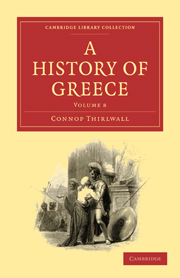Book contents
- Frontmatter
- Contents
- ERRATA
- CHAPTER LX FROM THE BATTLE OF IPSUS TO THE DEATH OF PYRRHUS
- CHAP. LXI FROM THE DEATH OF FYRRHUS TO THE ACCESSION OF ANTIGONUS DOSON
- CHAP. LXII FROM THE ACCESSION OF ANTIGONUS DOSON TO THE BATTLE OF SELLASIA
- CHAP. LXIII FROM THE BATTLE OF SELLASIA TO THE END OF THE SOCIAL WAR BETWEEN THE ACHÆANS AND ÆTOLIANS
- CHAP. LXIV FROM THE END OF THE SOCIAL WAR BETWEEN THE ÆTOLIANS AND THE ACHÆANS TO THE PROCLAMATION OF THE LIBERTY OF GREECE UNDER ROMAN PROTECTION
- CHAP. LXV FROM THE PROCLAMATION OF THE LIBERTY OF GREECE UNDER ROMAN PROTECTION TO THE EMBASSY OF CALLICRATES TO ROME
- CHAP. LXVI FROM THE EMBASSY OF CALLICRATES TO ROME TO THE REDUCTION OF GREECE INTO A ROMAN PROVINCE
- INDEX
CHAP. LXVI - FROM THE EMBASSY OF CALLICRATES TO ROME TO THE REDUCTION OF GREECE INTO A ROMAN PROVINCE
Published online by Cambridge University Press: 05 July 2011
- Frontmatter
- Contents
- ERRATA
- CHAPTER LX FROM THE BATTLE OF IPSUS TO THE DEATH OF PYRRHUS
- CHAP. LXI FROM THE DEATH OF FYRRHUS TO THE ACCESSION OF ANTIGONUS DOSON
- CHAP. LXII FROM THE ACCESSION OF ANTIGONUS DOSON TO THE BATTLE OF SELLASIA
- CHAP. LXIII FROM THE BATTLE OF SELLASIA TO THE END OF THE SOCIAL WAR BETWEEN THE ACHÆANS AND ÆTOLIANS
- CHAP. LXIV FROM THE END OF THE SOCIAL WAR BETWEEN THE ÆTOLIANS AND THE ACHÆANS TO THE PROCLAMATION OF THE LIBERTY OF GREECE UNDER ROMAN PROTECTION
- CHAP. LXV FROM THE PROCLAMATION OF THE LIBERTY OF GREECE UNDER ROMAN PROTECTION TO THE EMBASSY OF CALLICRATES TO ROME
- CHAP. LXVI FROM THE EMBASSY OF CALLICRATES TO ROME TO THE REDUCTION OF GREECE INTO A ROMAN PROVINCE
- INDEX
Summary
The Romans as we have seen had treated Philip with some degree of forbearance so long as they had anything to hope or to fear from him. To soothe him after the affront he had suffered when he was compelled to abandon the siege of Lamia, he had been permitted to make some petty conquests in Thessaly and the adjacent regions. The release of his son and the remission of the tribute concurred with his distrust of Antiochus and the Ætolians, to retain him on the Roman side until the contest with the Syrian monarchy was decided by the battle of Magnesia. But he had learnt by very costly experience that no reliance could be placed on the moderation of Rome: and after the conclusion of the peace he had bent all his thoughts toward repairing his losses, and increasing the internal strength of his kingdom. He began to recruit its exhausted population as well by regulations tending to encourage the growth of families, as by large draughts of Thracian colonists whom he transplanted to Macedonia; and strove to replenish his treasury, both by the improvement of all the branches of his ordinary revenue, and with the produce of the mines; resuming old works which had been interrupted, and opening others in many places before untried. On the other hand, the Romans could feel no confidence in a prince whom they had so deeply injured.
- Type
- Chapter
- Information
- A History of Greece , pp. 380 - 474Publisher: Cambridge University PressPrint publication year: 2010First published in: 1844



